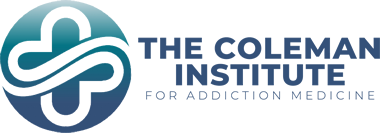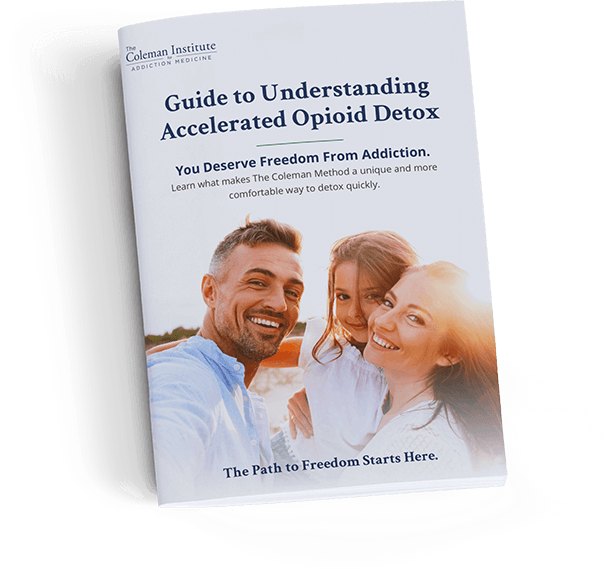
Common Myths About Addiction
Understanding addiction is the first step toward recovery. Unfortunately, harmful myths and misinformation about addiction persist in our society, unnecessarily confusing and frustrating those who struggle with opioid or alcohol dependency. Here are some common addiction myths—and facts—surrounding Substance Use Disorder.
Myth: Addiction is not treatable.
Fact: You can treat addiction.
Too often, people who are suffering from addiction feel as if there is no way out. What they don’t know is that addiction doesn’t have to be a death sentence or a lifelong curse. You can always find help, hope and healing. At the Coleman Institute, our accelerated outpatient detox provides a highly effective way to begin recovery. Our patients detox in a safe and comfortable environment, and we support their long-term success through our innovative Naltrexone Therapy.
Myth: Addiction could never happen to me.
Fact: Addiction can affect anyone.
Drug or alcohol addiction and dependency have nothing to do with race, gender or education level. Like many other chronic diseases, addiction is a hereditary disease that is often impacted by a family history of substance or alcohol use. Although no one chooses to have an addiction, certain behaviors and choices are more likely to lead to one. At the Coleman Institute, we have successfully treated thousands of people from a variety of backgrounds, including business executives, teenagers, senior citizens, parents and even doctors. Although their individual stories may be different, all are united in their desire to break free from addiction.
Myth: Addiction is just a lack of willpower.
Fact: Addiction is a disease.
Just as a person doesn’t choose to have an addiction, they also cannot simply choose to stop being addicted. In reality, addiction is a chronic brain disease that requires intensive and thorough treatment. Once a person becomes dependent on drugs or alcohol, their brain adjusts to the excessive amount of chemicals entering their body. As their body’s tolerance for the drug grows, they need to use higher and stronger doses just to function normally. This vicious cycle is almost impossible to stop without effective medical treatment.
Myth: Addiction and dependence are one and the same.
Fact: Addiction and dependence are different.
There is often confusion between addiction and dependence. When someone is dependent on a substance, this means they experience withdrawal symptoms if they decrease or stop the use of that substance. You can be dependent on drugs or alcohol without being addicted.
Addiction is a disease that can involve dependence, but not in every case. Like dependence, addiction is associated with chemical changes in the brain but addiction also involves elements such as changes in behavior that impact quality of life, increased substance use, fixation on the drug/substance despite negative consequences, and more.
Myth: You have to wait a long time for an open spot in a detox program.
Fact: There is currently no wait to get into detox at the Coleman Institute.
You don’t have to wait to get the assistance you need—with clinics around the country and a diverse team of experienced addiction medicine experts, the Coleman Institute is ready to help you get into detox. We offer outpatient detox options for Alcohol Use Disorder and Substance Use Disorder. Spots are open now! Request a callback here or call 877-773-3869 to speak with us right away.
Myth: All types of detox (withdrawal management) are the same.
Fact: There are many different types of detoxes available.
Detoxing on your own can be extremely difficult, as both alcohol and opioids can cause physical changes in your brain. Most people cannot stop using alcohol or opioids without severe withdrawal and may need to seek out professional help through medical detoxification. Common detox methods include:
- Self Detox: Stopping suddenly is known as “going cold turkey,” and this can be extremely uncomfortable. Most people try tapering or weaning themselves down, but this is rarely successful. This approach is usually so uncomfortable that most patients are unable to tolerate the pain and resort to using opiates or alcohol again. Self detox is not generally recommended due to the high probability of relapse and potential safety concerns.
- Ultra Rapid Opioid Detoxification (URD or UROD), Anesthesia Detox, or Sedation Detox: This inpatient, hospital-based method involves putting patients under general anesthesia and intravenously administering opioid antagonists such as Naltrexone. This process of flushing the drugs out of their system can take place in as few as five minutes. The UROD methodology comes with a high cost and serious medical risks, and can potentially be fatal.
- Inpatient Detoxification: Inpatient detox can take place in a hospital or rehab facility. Medical professionals supervise and administer the medications for pain and discomfort during the detox, as well as monitor the patient for safety. This method can be very expensive and often interrupts daily responsibilities. With inpatient detox, it is important to be aware that health insurance may not cover the full length of stay required to detox completely. The number of days required will vary with each patient.
- Outpatient Detoxification using The Coleman Method: Our unique approach provides a comfortable and successful alternative so that the whole detoxification can be conducted on an outpatient basis. Patients tell us that they love being in their own homes, and not in a sterile hospital environment. At the Coleman Institute for Addiction Medicine, 98% of patients successfully complete their detox without the risks and costs of general anesthesia, or the need to take an extended break from their daily responsibilities. We recognize that completing a detox is just the first step toward recovery; the brain must fully recover physically, and there are significant behavioral and environmental changes that are necessary. After the detox is completed, we use long-acting Naltrexone to help patients reduce their cravings and begin their recovery. Naltrexone is highly effective in bridging the gap between detox and recovery.



